#目标检测,#深度学习,#数据增强,#标签格式转换
1.数据增强
1.1使用ROBOFLOW进行数据增强
首先使用ROBOFLOW进行数据增强有一定的限制,而且增强的效果也比较一般,因为这个软件是外国的,所以国内的网很难打开,建议挂梯子使用。
打开roboflow的网址,注册一个账号,或者使用GitHub的账号都可以登录成功,登录成功后点击创建项目
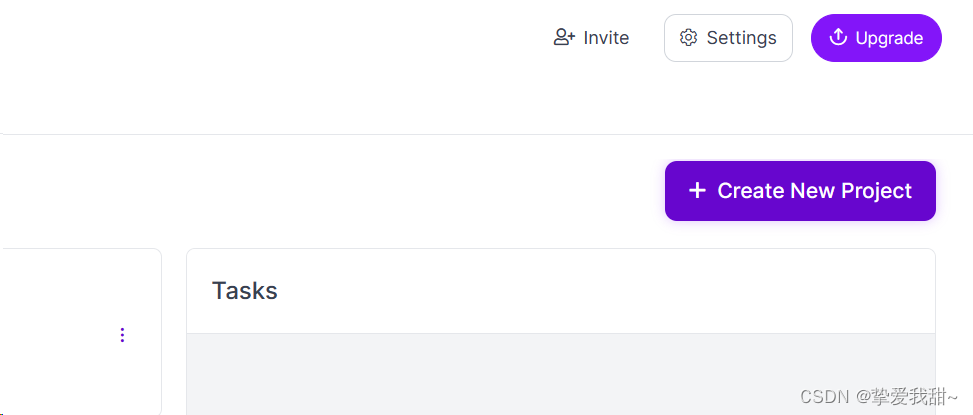

然后就会看见下一个页面,直接点击进去就行,不用修改。
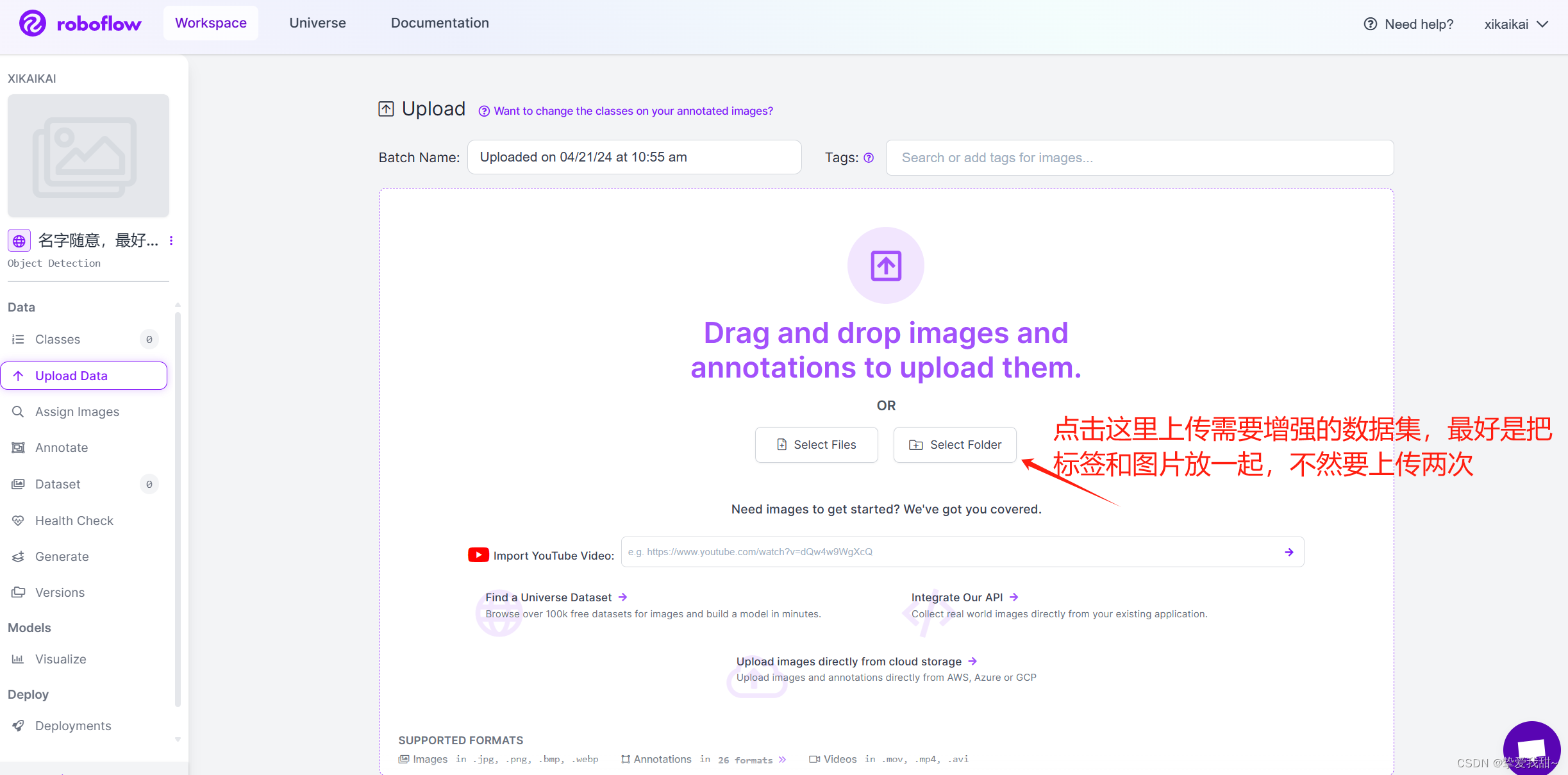
以下是不放一起的演示图:

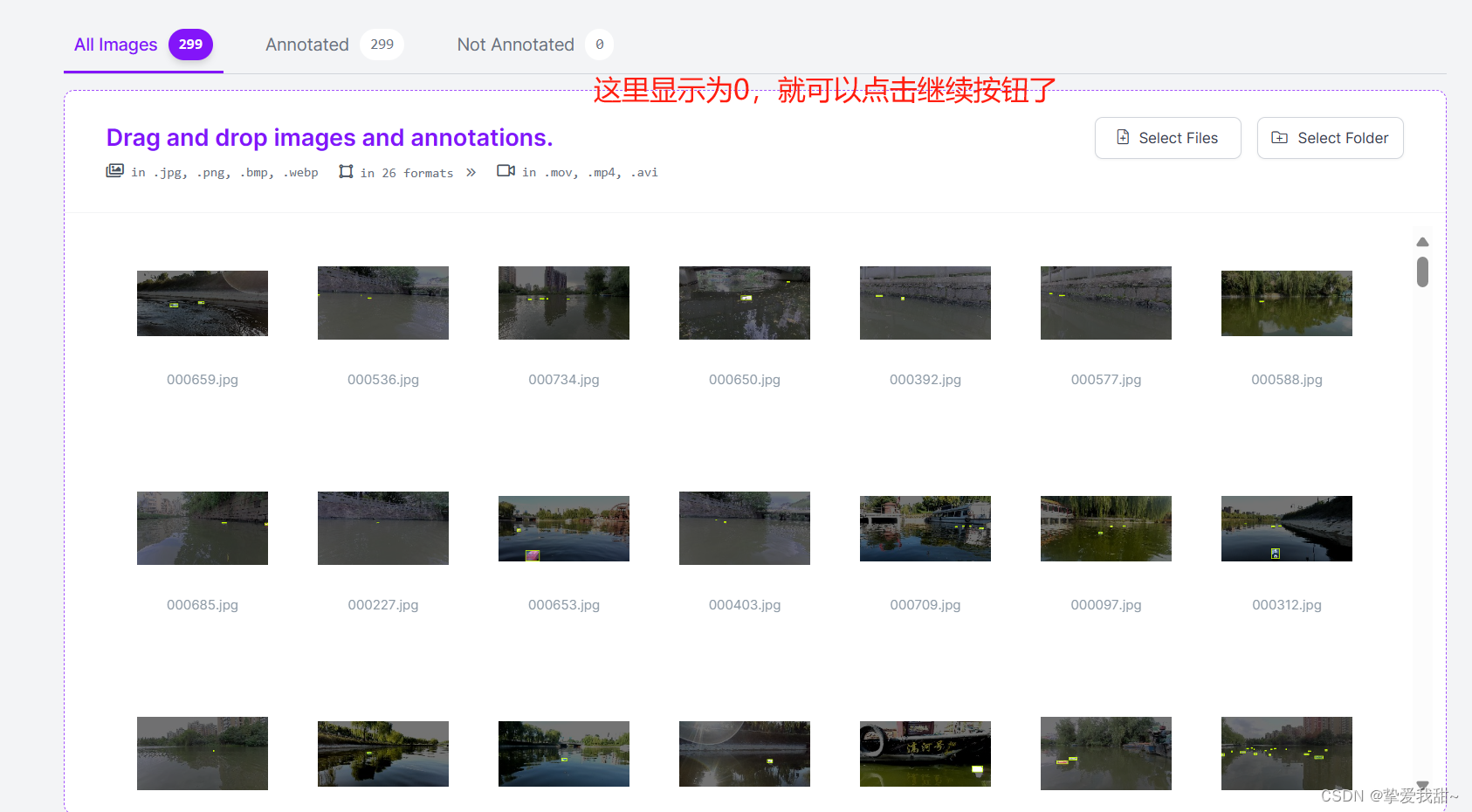
点击save and continue,等待上传数据集到项目中,下面的图片分配看个人喜好来,我的是80:15:5

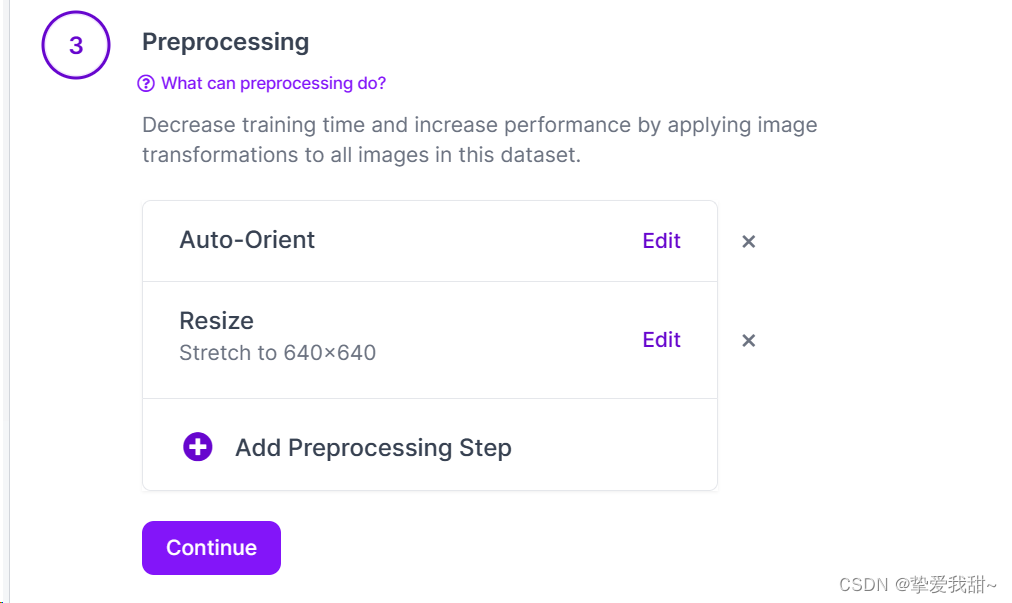
图片的尺寸按照自己的需求来修改

点击添加增强方式,里面有多种选择,建议选择三四种就行了,多了也不好,最后就可以点击生成了,没有充钱只可以增强一倍和两倍多点哦~
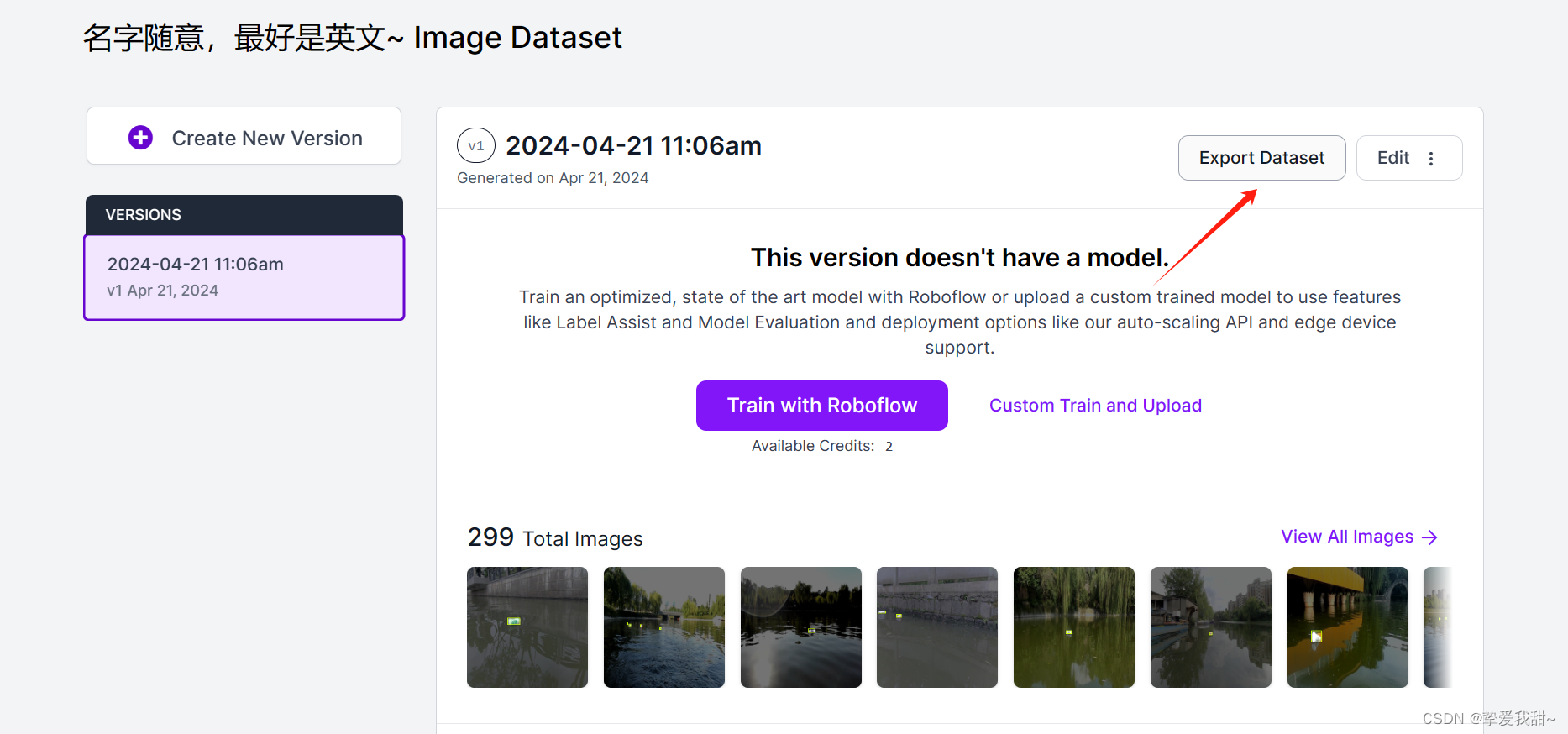
点击导出数据集:
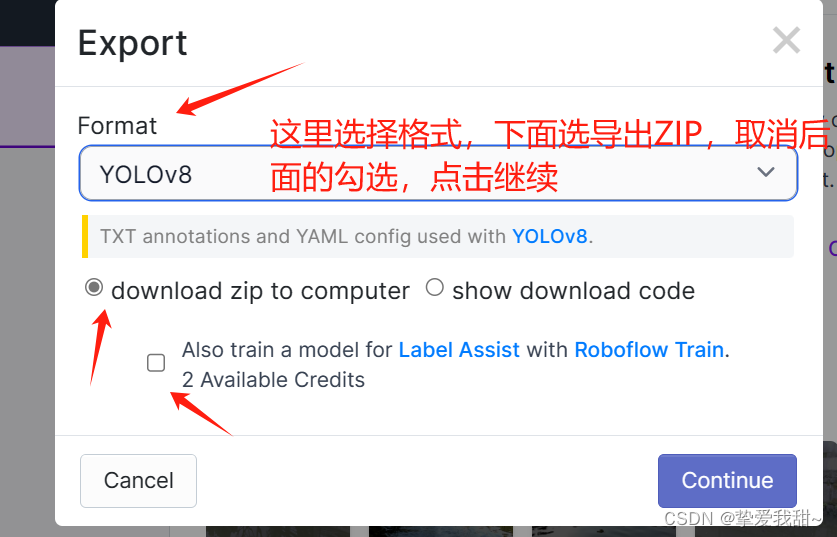
然后就完成ROBOFLOW数据增强啦(注意增强次数有限)。
1.2使用代码数据增强
直接放代码:
# -*- coding=utf-8 -*- # 裁剪(需改变bbox) # 2. 平移(需改变bbox) # 3. 改变亮度 # 4. 加噪声 # 5. 旋转角度(需要改变bbox) # 6. 镜像(需要改变bbox) # 7. cutout # 注意: # random.seed(),相同的seed,产生的随机数是一样 import time import random import copy import cv2 import os import math import numpy as np from skimage.util import random_noise from lxml import etree, objectify import xml.etree.ElementTree as ET import argparse # 显示图片 def show_pic(img, bboxes=None): ''' 输入: img:图像array bboxes:图像的所有boudning box list, 格式为[[x_min, y_min, x_max, y_max]....] names:每个box对应的名称 ''' for i in range(len(bboxes)): bbox = bboxes[i] x_min = bbox[0] y_min = bbox[1] x_max = bbox[2] y_max = bbox[3] cv2.rectangle(img, (int(x_min), int(y_min)), (int(x_max), int(y_max)), (0, 255, 0), 3) cv2.namedWindow('pic', 0) # 1表示原图 cv2.moveWindow('pic', 0, 0) cv2.resizeWindow('pic', 1200, 800) # 可视化的图片大小 cv2.imshow('pic', img) cv2.waitKey(0) cv2.destroyAllWindows() # 图像均为cv2读取 class DataAugmentForObjectDetection(): def __init__(self, rotation_rate=0.5, max_rotation_angle=5, crop_rate=0.5, shift_rate=0.5, change_light_rate=0.5, add_noise_rate=0.5, flip_rate=0.5, cutout_rate=0.5, cut_out_length=50, cut_out_holes=1, cut_out_threshold=0.5, is_addNoise=True, is_changeLight=True, is_cutout=False, is_rotate_img_bbox=True, is_crop_img_bboxes=True, is_shift_pic_bboxes=True, is_filp_pic_bboxes=True): # 配置各个操作的属性 self.rotation_rate = rotation_rate self.max_rotation_angle = max_rotation_angle self.crop_rate = crop_rate self.shift_rate = shift_rate self.change_light_rate = change_light_rate self.add_noise_rate = add_noise_rate self.flip_rate = flip_rate self.cutout_rate = cutout_rate self.cut_out_length = cut_out_length self.cut_out_holes = cut_out_holes self.cut_out_threshold = cut_out_threshold # 是否使用某种增强方式 self.is_addNoise = is_addNoise self.is_changeLight = is_changeLight self.is_cutout = is_cutout self.is_rotate_img_bbox = is_rotate_img_bbox self.is_crop_img_bboxes = is_crop_img_bboxes self.is_shift_pic_bboxes = is_shift_pic_bboxes self.is_filp_pic_bboxes = is_filp_pic_bboxes # 加噪声 def _addNoise(self, img): ''' 输入: img:图像array 输出: 加噪声后的图像array,由于输出的像素是在[0,1]之间,所以得乘以255 ''' # return cv2.GaussianBlur(img, (11, 11), 0) return random_noise(img, mode='gaussian', seed=int(time.time()), clip=True) * 255 # 调整亮度 def _changeLight(self, img): alpha = random.uniform(0.35, 1) blank = np.zeros(img.shape, img.dtype) return cv2.addWeighted(img, alpha, blank, 1 - alpha, 0) # cutout def _cutout(self, img, bboxes, length=100, n_holes=1, threshold=0.5): ''' 原版本:https://github.com/uoguelph-mlrg/Cutout/blob/master/util/cutout.py Randomly mask out one or more patches from an image. Args: img : a 3D numpy array,(h,w,c) bboxes : 框的坐标 n_holes (int): Number of patches to cut out of each image. length (int): The length (in pixels) of each square patch. ''' def cal_iou(boxA, boxB): ''' boxA, boxB为两个框,返回iou boxB为bouding box ''' # determine the (x, y)-coordinates of the intersection rectangle xA = max(boxA[0], boxB[0]) yA = max(boxA[1], boxB[1]) xB = min(boxA[2], boxB[2]) yB = min(boxA[3], boxB[3]) if xB <= xA or yB <= yA: return 0.0 # compute the area of intersection rectangle interArea = (xB - xA + 1) * (yB - yA + 1) # compute the area of both the prediction and ground-truth # rectangles boxAArea = (boxA[2] - boxA[0] + 1) * (boxA[3] - boxA[1] + 1) boxBArea = (boxB[2] - boxB[0] + 1) * (boxB[3] - boxB[1] + 1) iou = interArea / float(boxBArea) return iou # 得到h和w if img.ndim == 3: h, w, c = img.shape else: _, h, w, c = img.shape mask = np.ones((h, w, c), np.float32) for n in range(n_holes): chongdie = True # 看切割的区域是否与box重叠太多 while chongdie: y = np.random.randint(h) x = np.random.randint(w) y1 = np.clip(y - length // 2, 0, h) # numpy.clip(a, a_min, a_max, out=None), clip这个函数将将数组中的元素限制在a_min, a_max之间,大于a_max的就使得它等于 a_max,小于a_min,的就使得它等于a_min y2 = np.clip(y + length // 2, 0, h) x1 = np.clip(x - length // 2, 0, w) x2 = np.clip(x + length // 2, 0, w) chongdie = False for box in bboxes: if cal_iou([x1, y1, x2, y2], box) > threshold: chongdie = True break mask[y1: y2, x1: x2, :] = 0. img = img * mask return img # 旋转 def _rotate_img_bbox(self, img, bboxes, angle=5, scale=1.): ''' 参考:https://blog.csdn.net/u014540717/article/details/53301195crop_rate 输入: img:图像array,(h,w,c) bboxes:该图像包含的所有boundingboxs,一个list,每个元素为[x_min, y_min, x_max, y_max],要确保是数值 angle:旋转角度 scale:默认1 输出: rot_img:旋转后的图像array rot_bboxes:旋转后的boundingbox坐标list ''' # ---------------------- 旋转图像 ---------------------- w = img.shape[1] h = img.shape[0] # 角度变弧度 rangle = np.deg2rad(angle) # angle in radians # now calculate new image width and height nw = (abs(np.sin(rangle) * h) + abs(np.cos(rangle) * w)) * scale nh = (abs(np.cos(rangle) * h) + abs(np.sin(rangle) * w)) * scale # ask OpenCV for the rotation matrix rot_mat = cv2.getRotationMatrix2D((nw * 0.5, nh * 0.5), angle, scale) # calculate the move from the old center to the new center combined # with the rotation rot_move = np.dot(rot_mat, np.array([(nw - w) * 0.5, (nh - h) * 0.5, 0])) # the move only affects the translation, so update the translation rot_mat[0, 2] += rot_move[0] rot_mat[1, 2] += rot_move[1] # 仿射变换 rot_img = cv2.warpAffine(img, rot_mat, (int(math.ceil(nw)), int(math.ceil(nh))), flags=cv2.INTER_LANCZOS4) # ---------------------- 矫正bbox坐标 ---------------------- # rot_mat是最终的旋转矩阵 # 获取原始bbox的四个中点,然后将这四个点转换到旋转后的坐标系下 rot_bboxes = list() for bbox in bboxes: xmin = bbox[0] ymin = bbox[1] xmax = bbox[2] ymax = bbox[3] point1 = np.dot(rot_mat, np.array([(xmin + xmax) / 2, ymin, 1])) point2 = np.dot(rot_mat, np.array([xmax, (ymin + ymax) / 2, 1])) point3 = np.dot(rot_mat, np.array([(xmin + xmax) / 2, ymax, 1])) point4 = np.dot(rot_mat, np.array([xmin, (ymin + ymax) / 2, 1])) # 合并np.array concat = np.vstack((point1, point2, point3, point4)) # 改变array类型 concat = concat.astype(np.int32) # 得到旋转后的坐标 rx, ry, rw, rh = cv2.boundingRect(concat) rx_min = rx ry_min = ry rx_max = rx + rw ry_max = ry + rh # 加入list中 rot_bboxes.append([rx_min, ry_min, rx_max, ry_max]) return rot_img, rot_bboxes # 裁剪 def _crop_img_bboxes(self, img, bboxes): ''' 裁剪后的图片要包含所有的框 输入: img:图像array bboxes:该图像包含的所有boundingboxs,一个list,每个元素为[x_min, y_min, x_max, y_max],要确保是数值 输出: crop_img:裁剪后的图像array crop_bboxes:裁剪后的bounding box的坐标list ''' # ---------------------- 裁剪图像 ---------------------- w = img.shape[1] h = img.shape[0] x_min = w # 裁剪后的包含所有目标框的最小的框 x_max = 0 y_min = h y_max = 0 for bbox in bboxes: x_min = min(x_min, bbox[0]) y_min = min(y_min, bbox[1]) x_max = max(x_max, bbox[2]) y_max = max(y_max, bbox[3]) d_to_left = x_min # 包含所有目标框的最小框到左边的距离 d_to_right = w - x_max # 包含所有目标框的最小框到右边的距离 d_to_top = y_min # 包含所有目标框的最小框到顶端的距离 d_to_bottom = h - y_max # 包含所有目标框的最小框到底部的距离 # 随机扩展这个最小框 crop_x_min = int(x_min - random.uniform(0, d_to_left)) crop_y_min = int(y_min - random.uniform(0, d_to_top)) crop_x_max = int(x_max + random.uniform(0, d_to_right)) crop_y_max = int(y_max + random.uniform(0, d_to_bottom)) # 随机扩展这个最小框 , 防止别裁的太小 # crop_x_min = int(x_min - random.uniform(d_to_left//2, d_to_left)) # crop_y_min = int(y_min - random.uniform(d_to_top//2, d_to_top)) # crop_x_max = int(x_max + random.uniform(d_to_right//2, d_to_right)) # crop_y_max = int(y_max + random.uniform(d_to_bottom//2, d_to_bottom)) # 确保不要越界 crop_x_min = max(0, crop_x_min) crop_y_min = max(0, crop_y_min) crop_x_max = min(w, crop_x_max) crop_y_max = min(h, crop_y_max) crop_img = img[crop_y_min:crop_y_max, crop_x_min:crop_x_max] # ---------------------- 裁剪boundingbox ---------------------- # 裁剪后的boundingbox坐标计算 crop_bboxes = list() for bbox in bboxes: crop_bboxes.append([bbox[0] - crop_x_min, bbox[1] - crop_y_min, bbox[2] - crop_x_min, bbox[3] - crop_y_min]) return crop_img, crop_bboxes # 平移 def _shift_pic_bboxes(self, img, bboxes): ''' 参考:https://blog.csdn.net/sty945/article/details/79387054 平移后的图片要包含所有的框 输入: img:图像array bboxes:该图像包含的所有boundingboxs,一个list,每个元素为[x_min, y_min, x_max, y_max],要确保是数值 输出: shift_img:平移后的图像array shift_bboxes:平移后的bounding box的坐标list ''' # ---------------------- 平移图像 ---------------------- w = img.shape[1] h = img.shape[0] x_min = w # 裁剪后的包含所有目标框的最小的框 x_max = 0 y_min = h y_max = 0 for bbox in bboxes: x_min = min(x_min, bbox[0]) y_min = min(y_min, bbox[1]) x_max = max(x_max, bbox[2]) y_max = max(y_max, bbox[3]) d_to_left = x_min # 包含所有目标框的最大左移动距离 d_to_right = w - x_max # 包含所有目标框的最大右移动距离 d_to_top = y_min # 包含所有目标框的最大上移动距离 d_to_bottom = h - y_max # 包含所有目标框的最大下移动距离 x = random.uniform(-(d_to_left - 1) / 3, (d_to_right - 1) / 3) y = random.uniform(-(d_to_top - 1) / 3, (d_to_bottom - 1) / 3) M = np.float32([[1, 0, x], [0, 1, y]]) # x为向左或右移动的像素值,正为向右负为向左; y为向上或者向下移动的像素值,正为向下负为向上 shift_img = cv2.warpAffine(img, M, (img.shape[1], img.shape[0])) # ---------------------- 平移boundingbox ---------------------- shift_bboxes = list() for bbox in bboxes: shift_bboxes.append([bbox[0] + x, bbox[1] + y, bbox[2] + x, bbox[3] + y]) return shift_img, shift_bboxes # 镜像 def _filp_pic_bboxes(self, img, bboxes): ''' 参考:https://blog.csdn.net/jningwei/article/details/78753607 平移后的图片要包含所有的框 输入: img:图像array bboxes:该图像包含的所有boundingboxs,一个list,每个元素为[x_min, y_min, x_max, y_max],要确保是数值 输出: flip_img:平移后的图像array flip_bboxes:平移后的bounding box的坐标list ''' # ---------------------- 翻转图像 ---------------------- flip_img = copy.deepcopy(img) h, w, _ = img.shape sed = random.random() if 0 < sed < 0.33: # 0.33的概率水平翻转,0.33的概率垂直翻转,0.33是对角反转 flip_img = cv2.flip(flip_img, 0) # _flip_x inver = 0 elif 0.33 < sed < 0.66: flip_img = cv2.flip(flip_img, 1) # _flip_y inver = 1 else: flip_img = cv2.flip(flip_img, -1) # flip_x_y inver = -1 # ---------------------- 调整boundingbox ---------------------- flip_bboxes = list() for box in bboxes: x_min = box[0] y_min = box[1] x_max = box[2] y_max = box[3] if inver == 0: #0:垂直翻转 flip_bboxes.append([x_min, h - y_max, x_max, h - y_min]) elif inver == 1: # 1:水平翻转 flip_bboxes.append([w - x_max, y_min, w - x_min, y_max]) elif inver == -1: # -1:水平垂直翻转 flip_bboxes.append([w - x_max, h - y_max, w - x_min, h - y_min]) return flip_img, flip_bboxes # 图像增强方法 def dataAugment(self, img, bboxes): ''' 图像增强 输入: img:图像array bboxes:该图像的所有框坐标 输出: img:增强后的图像 bboxes:增强后图片对应的box ''' change_num = 0 # 改变的次数 # print('------') while change_num < 1: # 默认至少有一种数据增强生效 if self.is_rotate_img_bbox: if random.random() > self.rotation_rate: # 旋转 change_num += 1 angle = random.uniform(-self.max_rotation_angle, self.max_rotation_angle) scale = random.uniform(0.7, 0.8) img, bboxes = self._rotate_img_bbox(img, bboxes, angle, scale) if self.is_shift_pic_bboxes: if random.random() < self.shift_rate: # 平移 change_num += 1 img, bboxes = self._shift_pic_bboxes(img, bboxes) if self.is_changeLight: if random.random() > self.change_light_rate: # 改变亮度 change_num += 1 img = self._changeLight(img) if self.is_addNoise: if random.random() < self.add_noise_rate: # 加噪声 change_num += 1 img = self._addNoise(img) if self.is_cutout: if random.random() < self.cutout_rate: # cutout change_num += 1 img = self._cutout(img, bboxes, length=self.cut_out_length, n_holes=self.cut_out_holes, threshold=self.cut_out_threshold) if self.is_filp_pic_bboxes: if random.random() < self.flip_rate: # 翻转 change_num += 1 img, bboxes = self._filp_pic_bboxes(img, bboxes) return img, bboxes # xml解析工具 class ToolHelper(): # 从xml文件中提取bounding box信息, 格式为[[x_min, y_min, x_max, y_max, name]] def parse_xml(self, path): ''' 输入: xml_path: xml的文件路径 输出: 从xml文件中提取bounding box信息, 格式为[[x_min, y_min, x_max, y_max, name]] ''' tree = ET.parse(path) root = tree.getroot() objs = root.findall('object') coords = list() for ix, obj in enumerate(objs): name = obj.find('name').text box = obj.find('bndbox') x_min = int(box[0].text) y_min = int(box[1].text) x_max = int(box[2].text) y_max = int(box[3].text) coords.append([x_min, y_min, x_max, y_max, name]) return coords # 保存图片结果 def save_img(self, file_name, save_folder, img): cv2.imwrite(os.path.join(save_folder, file_name), img) # 保持xml结果 def save_xml(self, file_name, save_folder, img_info, height, width, channel, bboxs_info): ''' :param file_name:文件名 :param save_folder:#保存的xml文件的结果 :param height:图片的信息 :param width:图片的宽度 :param channel:通道 :return: ''' folder_name, img_name = img_info # 得到图片的信息 E = objectify.ElementMaker(annotate=False) anno_tree = E.annotation( E.folder(folder_name), E.filename(img_name), E.path(os.path.join(folder_name, img_name)), E.source( E.database('Unknown'), ), E.size( E.width(width), E.height(height), E.depth(channel) ), E.segmented(0), ) labels, bboxs = bboxs_info # 得到边框和标签信息 for label, box in zip(labels, bboxs): anno_tree.append( E.object( E.name(label), E.pose('Unspecified'), E.truncated('0'), E.difficult('0'), E.bndbox( E.xmin(box[0]), E.ymin(box[1]), E.xmax(box[2]), E.ymax(box[3]) ) )) etree.ElementTree(anno_tree).write(os.path.join(save_folder, file_name), pretty_print=True) if __name__ == '__main__': need_aug_num = 6 # 每张图片需要增强的次数 is_endwidth_dot = True # 文件是否以.jpg或者png结尾 dataAug = DataAugmentForObjectDetection() # 数据增强工具类 toolhelper = ToolHelper() # 工具 # 获取相关参数 parser = argparse.ArgumentParser() parser.add_argument('--source_img_path', type=str, default='D:/download/FloW_IMG/training/images') parser.add_argument('--source_xml_path', type=str, default='D:/download/FloW_IMG/training/annotations') parser.add_argument('--save_img_path', type=str, default='D:/datasets/Images') parser.add_argument('--save_xml_path', type=str, default='D:/datasets/Annotations') args = parser.parse_args() source_img_path = args.source_img_path # 图片原始位置 source_xml_path = args.source_xml_path # xml的原始位置 save_img_path = args.save_img_path # 图片增强结果保存文件 save_xml_path = args.save_xml_path # xml增强结果保存文件 # 如果保存文件夹不存在就创建 if not os.path.exists(save_img_path): os.mkdir(save_img_path) if not os.path.exists(save_xml_path): os.mkdir(save_xml_path) for parent, _, files in os.walk(source_img_path): files.sort() for file in files: cnt = 0 pic_path = os.path.join(parent, file) xml_path = os.path.join(source_xml_path, file[:-4] + '.xml') values = toolhelper.parse_xml(xml_path) # 解析得到box信息,格式为[[x_min,y_min,x_max,y_max,name]] coords = [v[:4] for v in values] # 得到框 labels = [v[-1] for v in values] # 对象的标签 # 如果图片是有后缀的 if is_endwidth_dot: # 找到文件的最后名字 dot_index = file.rfind('.') _file_prefix = file[:dot_index] # 文件名的前缀 _file_suffix = file[dot_index:] # 文件名的后缀 img = cv2.imread(pic_path) # show_pic(img, coords) # 显示原图 while cnt < need_aug_num: # 继续增强 auged_img, auged_bboxes = dataAug.dataAugment(img, coords) auged_bboxes_int = np.array(auged_bboxes).astype(np.int32) height, width, channel = auged_img.shape # 得到图片的属性 img_name = '{}_{}{}'.format(_file_prefix, cnt + 1, _file_suffix) # 图片保存的信息 toolhelper.save_img(img_name, save_img_path, auged_img) # 保存增强图片 toolhelper.save_xml('{}_{}.xml'.format(_file_prefix, cnt + 1), save_xml_path, (save_img_path, img_name), height, width, channel, (labels, auged_bboxes_int)) # 保存xml文件 # show_pic(auged_img, auged_bboxes) # 强化后的图 print(img_name) cnt += 1 # 继续增强下一张
此代码只需要修改505-508行的地址,前两个是原来的图片和标签地址,后两个是生成后可以存放的标签和图片地址,495行代码是修改生成的倍数,看个人需求来修改~
2.VOC格式转换为YOLO格式
2.1代码方式转换:
代码如下所示:
import xml.etree.ElementTree as ET import sys import os.path import cv2 class XmlParse: def __init__(self, file_path): # 初始化成员变量:self.tree 和 self.root 分别用于存储XML文件解析后的ElementTree对象和根节点;self.xml_file_path 存储传入的XML文件路径。 self.tree = None self.root = None self.xml_file_path = file_path # 使用 try...except...finally 结构处理可能出现的异常情况。 def ReadXml(self): # 该方法用于读取XML文件并解析为ElementTree对象。 try: self.tree = ET.parse(self.xml_file_path) # 使用 xml.etree.ElementTree.parse() 方法解析XML文件,将结果赋值给 self.tree self.root = self.tree.getroot() # 获取XML文件的根节点并赋值给 self.root。 except Exception as e: # 在 except Exception as e 块内,捕获并打印解析失败的错误信息,并通过 sys.exit() 终止程序执行。 print("parse xml faild!") sys.exit() else: pass finally: # finally 块会在不论是否出现异常的情况下都会被执行,这里返回解析好的 self.tree。 return self.tree def WriteXml(self, destfile): dses_xml_file = os.path.abspath(destfile) self.tree.write(dses_xml_file, encoding="utf-8", xml_declaration=True) def xml2txt(xml, labels, name_list, img_path): for i, j in zip(os.listdir(xml), os.listdir(img_path)): p = os.path.join(xml + '/' + i) # xml路径 xml_file = os.path.abspath(p) # 绝对路径 parse = XmlParse(xml_file) tree = parse.ReadXml() # xml树 root = tree.getroot() # 根节点 W = float(root.find('size').find('width').text) H = float(root.find('size').find('height').text) fil_name = root.find('filename').text[:-4] if not os.path.exists(labels): # 如果路径不存在则创建 os.mkdir(labels) out = open(labels + './' + fil_name + '.txt', 'w+') for obj in root.iter('object'): x_min = float(obj.find('bndbox').find('xmin').text) x_max = float(obj.find('bndbox').find('xmax').text) y_min = float(obj.find('bndbox').find('ymin').text) y_max = float(obj.find('bndbox').find('ymax').text) print(f'------------------------{i}-----------------------') print('W:', W, 'H:', H) # 计算公式 xcenter = x_min + (x_max - x_min) / 2 ycenter = y_min + (y_max - y_min) / 2 w = x_max - x_min h = y_max - y_min # 目标框的中心点 宽高 print('center_X: ', xcenter) print('center_Y: ', ycenter) print('target box_w: ', w) print('target box_h: ', h) # 归一化 xcenter = round(xcenter / W, 6) ycenter = round(ycenter / H, 6) w = round(w / W, 6) h = round(h / H, 6) print('>>>>>>>>>>') print(xcenter) print(ycenter) print(w) print(h) class_dict = dict(zip(name_list, range(0, len(name_list)))) class_name = obj.find('name').text if class_name not in name_list: pass else: class_id = class_dict[class_name] print('类别: ', class_id) print("创建成功: {}".format(fil_name + '.txt')) print('----------------------------------------------------') out.write(str(class_id) + " " + str(xcenter) + " " + str(ycenter) + " " + str(w) + " " + str(h) + "\n") # show_img m = os.path.join(img_path + '/' + j) block = cv2.imread(m) cv2.rectangle(block, pt1=(int((xcenter - w / 2) * W), int((ycenter - h / 2) * H)), pt2=(int((xcenter + w / 2) * W), int((ycenter + h / 2) * H)), color=(0, 255, 0), thickness=2) cv2.imshow('block', block) cv2.waitKey(300) def folder_Path(): img_path = 'D:/datasets/Images' xml_path = 'D:/datasets/Annotations' # xml路径 labels = 'D:/datasets/labels' # 转txt路径 name_list = ['bottle'] # 类别名 xml2txt(xml_path, labels, name_list, img_path) if __name__ == '__main__': folder_Path()
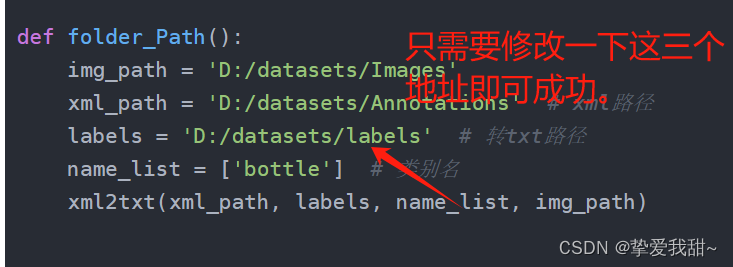
2.2 ROBOFLOW方式转换格式
在上面ROBOFLOW数据增强的基础上,不选择数据增强的方式,然后直接创建新的数据集,就会在原有的基础上进行,然后再导出相应的格式,格式转换就完成了,不过也是次数有限,希望大家珍惜每一次免费的机会哦~
以上就是今天分享的全部内容,如果有用,期待大家的关注哦~我会持续更新遇到的问题以及解决方案。





















 4647
4647











 被折叠的 条评论
为什么被折叠?
被折叠的 条评论
为什么被折叠?








